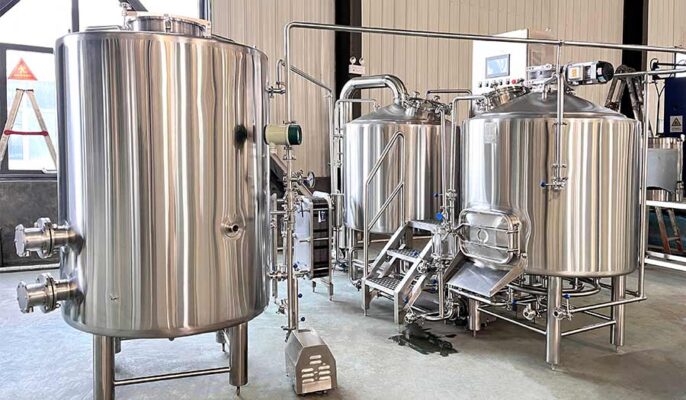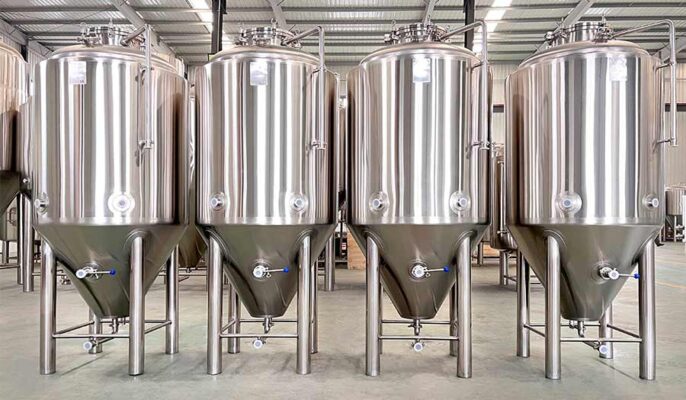In recent years, microbreweries have become popular among beer drinkers and brewers alike. Starting a microbrewery was their dream. But starting a microbrewery can be a difficult process, requiring a significant investment in equipment, and understanding the various components involved is crucial. Factors such as expected output, available space and budget need to be considered when selecting the right equipment.
What is a micro brewery factory equipment?
Beer brewing equipment refers to the machinery and tools used in the beer brewing process. It includes various ingredients that play a key role in the brewing process, from mashing and boiling to fermentation and packaging. Each piece of equipment helps create the unique flavor, aroma and character of the final brew.
The most important parts of microbrewery equipment include:
- Brewery: This is where the magic happens. A brewery usually consists of a mash barrel, a lauter barrel, a brewing kettle and a hot liquid tank.
- Fermenter: After the wort is boiled and cooled, it is transferred to a fermenter where yeast is added to convert the sugar into alcohol.
- Brite Cans: These cans are used to condition and carbonate beer before packaging.
- Packaging equipment: This includes keggers, bottlers, and other equipment needed to put beer into kegs, bottles, or cans.

Components of Brewery Equipment
Brewing kettle
A brew kettle is a large vessel used to boil wort, a key step in the brewing process where hops are added to give the beer its bitter taste and aroma. These kettles are usually made of stainless steel or copper and come in various sizes to suit different batch sizes.
Fermenter
The fermentor is where the fermentation magic happens. Yeast converts sugar into alcohol and carbon dioxide, and the fermenter provides a controlled environment for this process. These tanks are crucial in determining the flavor profile and alcohol content of the beer.
Mash bucket
A mash tun is a container used for mashing, a process in which sprouted grains are mixed with hot water to convert starch into fermentable sugars. Proper mashing is critical to extracting the desired flavor and color from the grains.
Wort cooler
After boiling, the hot wort needs to be cooled before yeast can be added for fermentation. Wort coolers reduce the temperature of your wort, preventing contamination and unwanted odors.
Pump
Pumps are used to move liquids between different vessels during the brewing process, such as wort and beer. They help maintain a steady flow and reduce the risk of oxidation.
Cleaning system
A reliable cleaning system is essential to maintaining the hygiene of your brewing equipment. Proper cleaning and sanitation prevents contamination and ensures the consistency of the final product.
Control Panel
Modern breweries often use control panels to automate and watch the brewing process. These panels allow brewers to manage temperature, time and other variables.
Types of microbrewery equipment
According to the brewing process, small breweries can be classified as follows:
|
EQUIPMENT TYPE |
PURPOSE |
|
Mash Tun |
Converts milled grain into a sugary liquid called wort |
|
Lauter Tun |
Separates the wort from the spent grain |
|
Brew Kettle |
Boils the wort with hops to create the desired flavor profile |
|
Fermentation Vessels |
Facilitates the fermentation process by providing a controlled environment |
|
Brite Tanks |
Conditions and carbonates the beer before packaging |
|
Packaging Equipment |
Fills kegs, bottles, or cans with the finished beer |
|
Auxiliary Equipment |
Includes pumps, heat exchangers, and other supporting equipment |
Microbrewery equipment space layout
When selecting small brewery equipment, factors such as capacity, available space, and overall design and layout must be considered.
|
FACTOR |
CONSIDERATIONS |
|
Capacity |
Determine your desired batch size and projected annual output. This will help you choose appropriately sized equipment. |
|
Spaces |
Assess the available space in your brewery, including ceiling height, floor layout, and access for installation and maintenance. |
|
Design |
Consider the overall design and ergonomics of the equipment, as well as its ease of use and maintenance. |
|
Layout |
Plan the equipment layout to ensure an efficient workflow, proper ventilation, and safe operation. |
|
Customization |
Many manufacturers offer customization options to tailor the equipment to your specific needs and preferences. |

Factors to consider when choosing microbrewery equipment
- Batch size and production capacity: When selecting brewery equipment, determining batch size and production capacity is crucial. Balancing current needs with future growth potential is critical.
- Materials and Construction: The choice of materials and construction affects the durability and maintenance requirements of the equipment. Stainless steel is a popular choice because of its longevity and resistance to corrosion.
- Heating and Cooling Options: Efficient heating and cooling systems are critical to maintaining precise temperatures during brewing and fermentation.
- Automation vs. Control: Automation can streamline the brewing process, but it’s critical to strike a balance between automation and manual control based on your brewing philosophy.
- Budget and Cost: When investing in brewery equipment, budget considerations are important. Balancing quality with affordability is critical to long-term success.
MICET is the most trusted place for beginners and professionals to buy the best beer equipment, selling the most popular and affordable beer equipment at reasonable prices. And provide free engineer services to meet your needs.
Advantages and Disadvantages of Microbrewery Equipment
Scalability
No matter how hot or cold it gets outside, people always have a craving for beer. This is true any time of year. Because of this, infidelity is likely to increase because you are always launching new products and services to please your customers’ needs. Small brewery equipment can grow and expand as demand increases. The initial investment to sale and install small brewery equipment can be costly.
Flexibility
Depending on your expectations, you can invest as much time as you feel is necessary to help the organization function well. If you love your job and have some basic understanding of business, you can start a business on a modest scale while handling everything yourself. Microbrewery equipment enables experimentation and production of various beer styles. While scalable, small brewery equipment may reach capacity limits as demand grows.
Customized services
Many suppliers offer customization options to tailor the equipment to your needs and characteristics. Help you get the products you need better. But larger equipment can need a lot of space, limiting options for smaller facilities.
Efficiency
Modern small brewery equipment is designed for efficient operation and energy conservation. The downside is that regular maintenance and cleaning are essential to ensure proper operation and product quality.
FAQ
Q: What is the smallest equipment needed to start a microbrewery?
A: The necessary equipment for a microbrewery includes mash barrels, lauter barrels, brewing kettles, fermenters, beer tanks and packaging equipment (filling machines, filling machines or canning production lines).
Q: How much space does a microbrewery need?
A: The space required for a small brewery can vary depending on equipment size and layout. As a general guideline, plan for a basic 3-barrel (bbl) brewery of at least 1,000 square feet with more space for fermentation, packaging, and storage.
Q: How do I choose the right size of equipment for my microbrewery?
A: Consider your projected output, growth plans and available space. It is often recommended to start with a system that is larger than initial needs to accommodate future growth.
Q: What are the typical maintenance requirements for microbrewery equipment?
A: Regular cleaning, inspections and preventive maintenance are crucial. Common maintenance tasks include cleaning the tank, replacing gaskets and seals, and checking pumps and other moving parts for wear.




